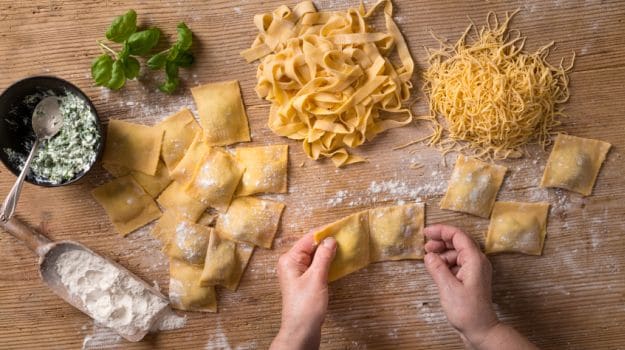Every year, Google releases a long report about the foods Americans are thinking about - or really searching for - the most. And normally it usually just confirms the obvious. You don't need a database to tell you that avocado toast is popular or that people like colorful sweets.But this time around the report uncovered something that's actually pretty amusing. Tucked inside the 75 pages is a trend Google calls the "Pasta Comeback." The gist is that online interest in pasta is growing - and fast.The rise of rigatoni is perhaps the best example. Search interest in the short, tube-shaped pasta was 26 percent higher this past January than the one before. But pastas of many shapes and sizes (linguine, penne, fusilli and others) appear to increasingly be on peoples' minds, too, according to the report.
It's hard to argue with the broader growth in online interest in pasta. But there's an important quirk here, which is what makes this all so interesting: Google is extrapolating from search data, not sales data, and the latter tell a pretty different story.Americans might be fond of tortellini on the Internet, but they don't seem to feel the same way about it on their plates. Pasta consumption was lower this past year than it was the year before (by about 1 percent), and lower the year before than it was the year before that (about 1.5 percent lower), according to data from market research firm Nielsen.What's more, the dip isn't just a two-year blip.Since 2009, sales of dried pasta, which accounts for the vast majority of pasta purchased in the United States, have fallen by 6 percent in North America, according to a report released last year. And they're expected to continue to fall through at least 2019.Taken together, these two realizations are, well, kind of weird. People are searching more and more for pasta just as they're eating less and less of it. They're ogling it even though they are also slowly abandoning it.What exactly is going on is unclear. But there are a few things that might help explain the bizarre duality of divergent trends.A good place to start is the reason why people are shying away from eating pasta today. It isn't fatigue that's dragging the food down. Nor do people seem to find it any less delicious than they once did. Rather, pasta is most likely suffering because it finds itself at an unfortunate intersection, on the wrong side of a couple important trends.The first is the rising popularity of carb-free diets, which doesn't exactly help pasta. The second is the growing importance of health to consumers, which sideswipes the doughy food, since it offers little in the way of new nutrition."What all these fad diets have done is identify what's a good carb and what's a bad carb for people," Darren Seifer, a food and beverage analyst at market research firm NPD Group, said last year. "The problem for pasta is that we found out that things like pasta are part of the bad group."
In other words, it isn't necessarily that people don't want to eat more pasta - it's just that they feel like they should probably cut down. And in that light, the rise of pasta window shopping seems to make a little more sense.(c) 2016, The Washington Post(This story has not been edited by NDTV staff and is auto-generated from a syndicated feed.)
It's hard to argue with the broader growth in online interest in pasta. But there's an important quirk here, which is what makes this all so interesting: Google is extrapolating from search data, not sales data, and the latter tell a pretty different story.Americans might be fond of tortellini on the Internet, but they don't seem to feel the same way about it on their plates. Pasta consumption was lower this past year than it was the year before (by about 1 percent), and lower the year before than it was the year before that (about 1.5 percent lower), according to data from market research firm Nielsen.What's more, the dip isn't just a two-year blip.Since 2009, sales of dried pasta, which accounts for the vast majority of pasta purchased in the United States, have fallen by 6 percent in North America, according to a report released last year. And they're expected to continue to fall through at least 2019.Taken together, these two realizations are, well, kind of weird. People are searching more and more for pasta just as they're eating less and less of it. They're ogling it even though they are also slowly abandoning it.What exactly is going on is unclear. But there are a few things that might help explain the bizarre duality of divergent trends.A good place to start is the reason why people are shying away from eating pasta today. It isn't fatigue that's dragging the food down. Nor do people seem to find it any less delicious than they once did. Rather, pasta is most likely suffering because it finds itself at an unfortunate intersection, on the wrong side of a couple important trends.The first is the rising popularity of carb-free diets, which doesn't exactly help pasta. The second is the growing importance of health to consumers, which sideswipes the doughy food, since it offers little in the way of new nutrition."What all these fad diets have done is identify what's a good carb and what's a bad carb for people," Darren Seifer, a food and beverage analyst at market research firm NPD Group, said last year. "The problem for pasta is that we found out that things like pasta are part of the bad group."
In other words, it isn't necessarily that people don't want to eat more pasta - it's just that they feel like they should probably cut down. And in that light, the rise of pasta window shopping seems to make a little more sense.(c) 2016, The Washington Post(This story has not been edited by NDTV staff and is auto-generated from a syndicated feed.)
Advertisement







